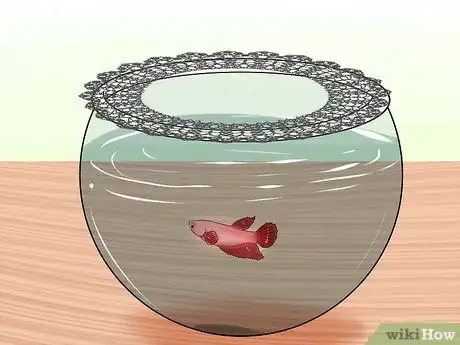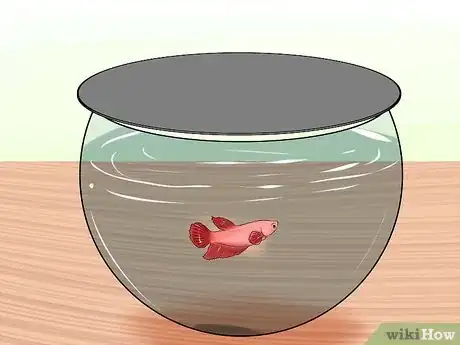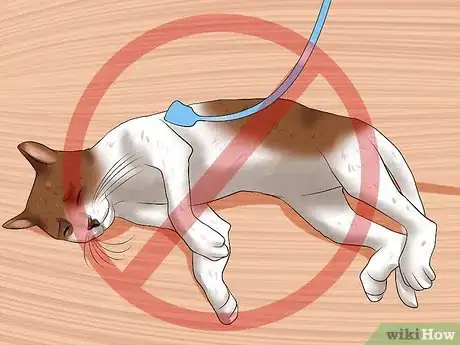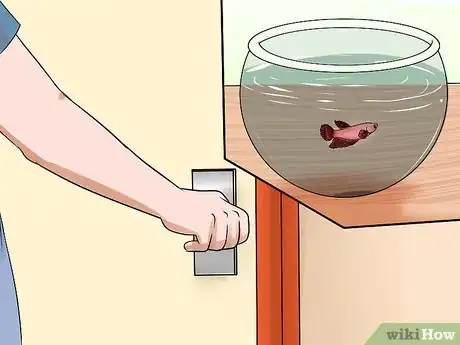This article was co-authored by Marshall Stephens. Marshall Stephens is an Aquarium Expert at Private Oceans Aquariums in West Palm Beach, Florida. Marshall has over 20 years of experience in the aquarium industry and focuses on captive-bred animals. They specialize in tropical and marine aquariums and are a contributor to the Loggerhead Marine life center in Jupiter Florida.
There are 9 references cited in this article, which can be found at the bottom of the page.
This article has been viewed 81,941 times.
There is a delicate balancing act in store for owners of both cats and fish. These hunters and prey never dwell together without some drama, and the younger the cat, the more the mischief. If you’re looking into ways of helping your pets coexist, these steps will keep your beloved fish and frisky feline in a semblance of harmony.
Steps
Protecting Your Fish
-
1Secure its location. If you’re in protection mode for your fish, the first thing to think about is the location of the fish bowl or tank. Is it easy for your cat to jump up and peer inside? If so, find a spot that at least delays your cat’s intrusion into the fish ecosystem long enough for you to rescue the fish, such as up in a cabinet or on a high mantel.
- Exploration is the name of a cat’s game, especially for a kitten. Try keeping the fish bowl away from surfaces cats like to jump on: tables, sideboards, cabinets, and bookshelves.[1]
-
2Secure a doily over it. If you have any doilies on hand, put them to use over a fish bowl. Take a large rubber band and stretch a doily over the top of the fish bowl, snapping the rubber band in place under the lip of the bowl.
- You can sprinkle fish food into the bowl without having to remove a lid this way.
- The doily should have a tight weave so that no cat could fit its paws or snout through the holes.
Advertisement -
3Put a lid on it. If you don’t have any doilies or your fish container is too large, consider adding a lid. A tight fitting secure top is probably the best solution. Test out any lid you already have on hand to see if the cat can penetrate it. Make sure the lid is very heavy or snaps onto the edges very tightly so that even you have a hard time getting it off.
- Don't just place a heavy plate over the top. Cats can be very resourceful with a plate or other covering that isn’t secured in place.
- Make sure there is a hole in the lid for airflow.[2]
- You may be able to find a lid that fits your fish tank at a store that sells containers.
-
4Buy a secure tank. If your current setup doesn’t allow you to place a secure lid on the fish container, consider purchasing a tank with a lid. Many pet stores and big box stores sell fish tanks and bowls with lids. [3]
-
5Move the fish. One sure-fire way to keep your cats out of the water of a fish bowl is to move the fish to a room where the cats don’t go. If you like looking at your fish, designate a room you frequent as a no-cat zone.
- You could start blocking off a bathroom.
- If you like the fish more as a decoration, you could lock it in an unused bedroom. Just be sure to go in this room everyday to feed the fish.
Training Your Cat
-
1Refrain from physical & verbal punishment. Cats do not respond well to physical punishment like spankings and verbal punishments like yelling. Instead of learning not to repeat the behavior, the cat will learn to fear you and perform the naughty acts when you aren’t around.[4]
- Keep in mind that cats have a real need to explore and hunt. Understanding this will help you have patience with your pet.[5]
- You can walk away when a cat starts to play in a violent way (like a play attack).
- You can also use a popgun, air horn, or squeeze bottle with water. Water in their faces when they can’t see the source will teach them not to return to the crime.
-
2Instigate environmental punishments. Also called “remote punishment” or “booby trapping,” placing things in a cat’s environment it doesn’t like keeps it from repeating a behavior.[6]
- For example, any textured surface cats don’t like can be placed around the fish, such as sticky paper, aluminum foil, or a plastic carpet runner with the nubby side turned up.
- You can also place smells offensive to cats near the fish bowl. Cats hate the smell of eucalyptus, citronella, and wintergreen.
-
3Keep your cat off of surfaces. Cats naturally enjoy being up high where they can survey their environment, but that also means they like to get up on counters and tables—where fish usually live. You can train them to stay off of your surfaces, however, by doing the following: [7]
- Taking everything off of tabletops and counters, so there’s nothing to investigate.
- Providing high, safe places to climb up to, like scratching posts.
- Placing treats at safe spots both on the floor and up on cat posts.
- Removing food and things of interest from the area near the fish bowl.
-
4Distract your cat. Giving your cat interesting things to do will keep it occupied so that it “forgets” about the fish, or at least gets its energy and curiosity satisfied elsewhere. Don’t forget to exercise your cat by playing with it on a regular basis.
- A motorized mouse can keep a cat occupied because it loves the chase. Good “mousing” breeds include both the American and British Shorthair, and mixed breed cats adopted from shelters.[8]
- A ping-pong paddle with a ball attached by rubber band will exercise a cat if you sit and fling the ball out over and over.
- Cats love to chase the tiny circle of a flashlight when it is moved around on surfaces.
-
5Place a water bowl in front of the fish. If your cat seems more interested in the water than the fish itself, this might just be a fascination with water or the container the water is in. Placing a small glass bowl of water in front of the fish bowl might distract your cat from the real thing.
- Investing in a cat fountain can also be a solution to the water fascination. Since cats are naturally drawn to moving water because it makes them think of clean water in the wild, a pet fountain can be just what you need to tempt your cat away from the fish bowl.[9]
Considering Alternatives to Training
-
1Choose one or the other. Another thing to consider is keeping only the fish or the cat, especially if nothing you try keeps your cat from attacking the fish bowl. Cats usually can't resist the fascination of a constantly moving, shimmering body, often exploring a fish bowl and eventually popping the fish in its mouth.[10] Since this is is the case, getting rid of one or other might be best for both parties.
- Decide which pet you have a greater attachment to, then give away the other one.
-
2Train your cat to live outside. Many people have outdoor cats. If your indoor cat will not stay away from the fish tank no matter what you do, you might try training your cat to live outside, at least part time.
- Start slowly at first, dismissing your cat to the backyard for only 10 minutes the first day, then gradually increasing their outdoor time.
- Feed your cat indoors and let them out and in at the same time everyday. Feeding your cat outside will attract wildlife.
- Give your cat a treat as soon as it comes inside each day to keep it wanting to come indoors.
- Having your cat inside only at certain times of day will allow you to properly protect the fish, perhaps locking up the fish when the cat is inside.
-
3Put your fish away. When you leave the house, put your fish in a locked room so that the cat can’t get to it. Even if you believe your cat is trained to leave the fish alone, eliminating the possibility of mischief keeps your cat from being tempted.
Warnings
- Some cats never grow out of hunting the fish they live with.⧼thumbs_response⧽
Expert Interview

Thanks for reading our article! If you'd like to learn more about taking care of a fish, check out our in-depth interview with Marshall Stephens.
References
- ↑ http://www.humanesociety.org/animals/cats/tips/cat_proofing_your_house.html
- ↑ http://www.petmd.com/fish/care/evr_fi_how-to-take-care-of-betta-fish
- ↑ http://www.whichfishtank.com
- ↑ https://www.mspca.org/pet_resources/correcting-unwanted-cat-behavior/
- ↑ http://feline-nutrition.org/the-blogs/your-kitty-may-need-to-go-to-chunk-school
- ↑ http://www.vcahospitals.com/main/pet-health-information/article/animal-health/undesirable-behavior-in-cats/197
- ↑ http://www.humanesociety.org/animals/cats/tips/cat_proofing_your_house.html
- ↑ http://cattime.com/cat-facts/lifestyle/1916-10-facts-about-cats-and-mice
- ↑ http://www.petfountain.com
About This Article
It can be hard to keep fish when you have cats that like to hunt, but you can make it work if you take extra precautions. If it’s possible, keep your fish on a high mantle or somewhere that would be hard for your cat to reach. For a fish that’s kept in a bowl, secure a doily over the top, so you can still feed the fish but the cat can’t reach into the bowl. If you have a bigger tank, place a secure lid on the tank, but make sure there are holes in the lid to allow air to flow. You may need to buy a new tank if you can’t find a secure lid for the one you have. For tips from our Veterinary co-author on how to train your cat to leave the fish alone, read on!









































































